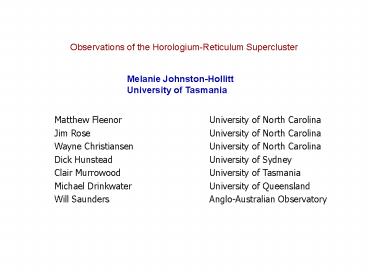P1252428529yIcQv - PowerPoint PPT Presentation
1 / 23
Title:
P1252428529yIcQv
Description:
We are conducting multi-wavelength observations of 12 x ... ATCA continuum imaging at 1.4, & 4.8 GHz over selected parts. X-ray: Chandra imaging of the ... – PowerPoint PPT presentation
Number of Views:37
Avg rating:3.0/5.0
Title: P1252428529yIcQv
1
Observations of the Horologium-Reticulum
Supercluster
Melanie Johnston-Hollitt University of Tasmania
Matthew Fleenor Jim Rose Wayne
Christiansen Dick Hunstead Clair
Murrowood Michael Drinkwater Will Saunders
University of North Carolina University of
North Carolina University of North
Carolina University of Sydney University of
Tasmania University of Queensland Anglo-Australian
Observatory
2
Observations of the Horologium-Reticulum
Supercluster
- We are conducting multi-wavelength observations
of 12 x 12 degrees centered on the HRS, this will
comprise - Optical
- 6dF over the whole area
- 2dF over selected parts
- 2.3m observations of bright cluster galaxies for
AMP clusters - Radio
- ATCA continuum imaging at 1.4, 4.8 GHz over
selected parts - X-ray
- Chandra imaging of the central galaxies in the
HRS - Existing XMM data is available for some cluster
members - consortium proposal for XMM observations along
the major cluster axis (PI Bohringer)
3
Observations of the Horologium-Reticulum
Supercluster Rationale
- To examine the dynamical state of the HRS outside
of rich clusters - To better understand and define the supercluster
and compare it to similar mass concentrations
like Shapley (define the extent of the
supercluster, mass etc) - To examining environmental affects and vice versa
ie using tailed radio galaxies as a barometer for
cluster weather - To understand merging timescales of individual
galaxy components - To examine the velocity dispersion of large-scale
filamentary structure
4
Horologium-Reticulum Supercluster (HRS)
center ? 3h18m43s, ? -5001'40" (E94)
zavg 0.0556, cz ? 19000 km s-1
18-24 ACO member clusters (Z93, E94) Covers (at
least) 100 square degrees on the sky
Back of the Envelope Calculations (Ho70 km
s-1 Mpc-1, cz ? 18000 km s-1) Dimensions Dista
nce cz Ho -1 257 Mpc Da ? 1h ? 13 (58
Mpc), Dd ? 15 (67 Mpc)
Kalinkov et al, MNRAS, 308(1998) Einasto et al,
MNRAS, 269(1994) Zucca et al, ApJ, 407(1993)
5
6dF Observations of the Horologium-Reticulum
Supercluster
- Goal to produce a catalog of galaxies in the
inter-cluster region - Target Selection complete catalog of galaxies
down to Bj17.5 in a 12 x 12 degree region was
extracted from SuperCOSMOS excluding 2 Abell
radii around known clusters 2848 a subset of
1500 targets was then chosen randomly from a
weighted list (so as to preserve the natural
overdensity). - Observations folded into the 6dFGS, taken in
Oct/Nov 2002 with 580V/425R (5/8 nights ok)
6
Fleenor et al, 2005, AJ (submitted)
7
6dF Observations of the Horologium-Reticulum
Supercluster
- Results 95 of targets gave reliable redshifts
- 547 spectra obtained
- (23 complete down to Bj17.5)
- This more than doubles the previous observations
of the inter-cluster field galaxies.
8
Fleenor et al, 2005, AJ (submitted)
9
Observations of the Horologium-Reticulum
Supercluster First 6dF results
- Kinematic Extent of the HRS
- Between 18 and 24 cluster members of which 17
ACO clusters lie in our region. We use these to
define a kinematic core for the HRS being the
FWHM of the observed z distribution of ACO
clusters gt 17,000 -22,500 km/s - -gt find 48 of inter-cluster galaxies lie within
this kinematic core
10
Fleenor et al, 2005, AJ (submitted)
11
Observations of the Horologium-Reticulum
Supercluster First 6dF results
- Overdensity for the Inter-cluster region
- from our redshift database we derived and
overdensity of 2.4 (using the method of
Drinkwater et al 2004) - Large-scale redshift trend
- Careful examination of the 2D z-slices was used
to further analyze the large-scale structure,
followed by a correlation analysis to define the
principle axis of the inter-cluster galaxies.
(Full details in Fleenor et al 2005). - Discovered that the HRS is defined along an SE-NW
axis of increasing z and that it is bimodal
12
Observations of the Horologium-Reticulum
Supercluster First 6dF results
- We have 4 main results that can be summarised
thus - The HRS spans the velocity range of at least
17,000 -22,500 km/s - The overdensity in this region is estimated to be
2.4 - There is a systematic trend of increasing
redshift along an SE-NW axis - The HRS is bimodal in redshift with a separation
of 2500 km/s between the peaks of each
component. - The HRS appears to comprise of 2 components in
redshift space, each exhibiting a similar
spatical-redshift trend along a SE-NW axis
13
HRS Redshift Catalog Inner 122 deg
- 3000 Redshifts
- currently (4500)
- Detailed kinematic
- analysis of the
- A3128/A3125
- region (multi-l)
Work of Matthew Fleenor (PhD Thesis)
14
Rose et al. (2002) A3128/A3125
- 2dF study with 500 redshifts -statistica
lly defined many filaments and groupings
that have undergone acceleration due to HRS
potential
15
(No Transcript)
16
(No Transcript)
17
Honours project of Clair Murrowood, UTas
18
Honours project of Clair Murrowood, UTas
19
Honours project of Clair Murrowood, UTas
20
(No Transcript)
21
But wait theres more.
- More 6dF observations were carried out over 6
nights in November 2004. This gave another 1100
redshifts in the inter-cluster region
22
16 - 16.5 red 15.5- 16 blue
17 - 17.5 red 16.5- 17 blue
20 - 20.5 red 19.5- 20 blue
21 - 21.5 red 20.5- 21 blue
18 - 18.5 red 17.5- 18 blue
19 - 19.5 red 18.5- 19 blue
22 - 22.5 red 21.5- 22 blue
23 - 23.5 red 22.5- 23 blue
Fleenor et al, - new results from yesterday!
Now we have the fun job of quantifying structure!
23
Acknowledgements
- We thank the staff of the AAO and particular
those involved in the 6dF galaxy survey, special
thanks go to Fred Watson, Paul Cass and Will
Saunders for supervising and conducting our
observations.































